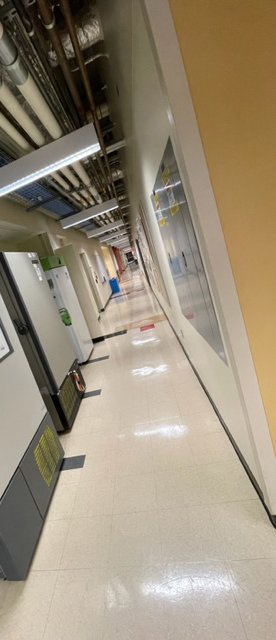
Who doesn’t like the way a new building looks just before it opens? The hallways and stairwells are clear, and the mechanical rooms are clean. Everything looks pristine. But we all know that it’s not likely to stay that way. Space on campus is valuable and there never seems to be enough. Storage and other items end up being placed where they present serious hazards including the obstruction of egress during an emergency.
Not Enough Space
Where do storage and other items go when there is not enough space? Hallways are quite common. They are convenient and right outside the door. It may not be obvious who “owns” the hallway. It may be “owned” by the department that occupies the building or “owned” by Facilities Management. In some cases, if a department is the primary occupant (e.g., Chemistry Department in the Chemistry Building), they may believe they “own” the hallway. If they “own” it, why can’t they use it the way they want?
 Occupants may think that the hallway is wide enough or that the space beyond the last door is usable for any purpose. Most occupants are not familiar with the requirements for egress or realize that in addition to width, there are considerations such as combustibility/hazard of materials, potential for items to shift and move into travel paths, and obstruction of exits. In fairness, new building designs and modern codes can blur the distinction of a space as a corridor by incorporating lounge areas, kitchenettes (refrigerator, sink, microwave) and other low-hazard amenities. Long, fire-separated corridors are no longer the norm.
Occupants may think that the hallway is wide enough or that the space beyond the last door is usable for any purpose. Most occupants are not familiar with the requirements for egress or realize that in addition to width, there are considerations such as combustibility/hazard of materials, potential for items to shift and move into travel paths, and obstruction of exits. In fairness, new building designs and modern codes can blur the distinction of a space as a corridor by incorporating lounge areas, kitchenettes (refrigerator, sink, microwave) and other low-hazard amenities. Long, fire-separated corridors are no longer the norm.
Stairwells, however, must always be kept clear. Stairwells are essential exit enclosures that provide fire-protected egress. They are attractive for storage because they often have what looks like wasted, open space under the stairs, but nothing is permitted to be stored there. Occupants and maintenance personnel tend to use the area under stairs for an array of items from housekeeping equipment to filing cabinets.
Mechanical rooms are spaces that are prime for storage by those who have authorized access—as well as those who do not. Facilities management personnel who work in mechanical rooms need storage that is convenient to their work. A good example is the storage of filters, belts, and other HVAC equipment. Storing a limited supply of these items for maintenance and operation of the equipment in the room is reasonable and generally acceptable under fire codes, but a year’s supply or creating a central storage location presents a hazard. Electrical spaces are of significant concern. Immediate egress and clear workspace around equipment are critical fire code and OSHA requirements.
Mechanical rooms can also serve as locations for offices for facilities management staff and contractors as well as other uses. It is not unusual to find contractor’s job boxes and other equipment in a mechanical room because they have access, and the room provides convenient security and proximity to their work. These items can also block fire sprinkler valves and fire alarm control panels.
Unique and New Challenges
Our ever-changing world brings new challenges. Micro-mobility devices – electric scooters, hoverboards, and skateboards are everywhere on campuses and will remain popular. The batteries and charging of these devices present potential fire hazards. Where can they be stored and charged? The codes have not caught up yet to address this specific hazard. We must use what is currently applicable and apply our best judgment to address this situation. Many campuses do not allow these devices to be brought into buildings, but it is difficult to keep them out. The reality is that they are expensive, difficult to secure, and there aren’t many places to charge them outside. We may need properly designed and protected space in buildings to store and charge these devices.
Regulations on the arrangement and restrictions for storage, as well as construction requirements for storage spaces, can be found in the model codes (NFPA, IFC, IBC, etc.) and OSHA. For example, NFPA 101 Life Safety Code (2018 Ed.) Section 7.2.2.5.3 has specific requirements for use of space within exit enclosures and prohibits the use of open space in exit enclosures for any purpose that has the potential to interfere with egress. OSHA 1910.303 and NFPA 70 National Electrical Code (2020 Ed.) prohibit storage within workspaces of electrical equipment. OSHA 1920.36 addresses clear access to egress.
Space Solutions
What are solutions to lack of storage space? Well, the obvious answer is more space. However, getting space specifically assigned for storage into the design for a new building is difficult. Below are strategies that can help address storage:
- Educate occupants. If they know the downside of putting items in the hallway or a mechanical space, they may be less likely to do it.
- Educate facilities management staff. Knowledgeable staff will be able to evaluate whether they can complete the work order for an equipment installation in a hallway, stairwell, or other inappropriate location.
- Encourage routine inspections by facilities management personnel of mechanical spaces that they work in. Inspections don’t have to be performed by a fire or safety official. Staff are likely to take responsibility for their own space.
- Manage surplus property. A good example is Terrapin Trader at the University of Maryland that, as described on their webpage, “handles the removal of university-owned equipment in environmentally responsible ways, such as sales, bids, and auctions. The store is open to UMD departments, other state agencies, faculty, staff, students and the general public.”
- Arrange authorized storage locations in conformance with codes and protect them with properly designed sprinkler systems.
Accommodating storage needs will remain a challenge on every campus. It is important to manage storage because of the potential impact on the safety of occupants, workers—and not to be overlooked, firefighters who may need to navigate smoke filled corridors to fight a fire—as well as the potential impact on operations of the institution.
Alan Sactor is the University of Maryland Fire Marshal and assistant director at the Department of Environmental Safety, Sustainability and Risk. Alan is also vice president at the Center for Campus Fire Safety and a member of the APPA Standards and Codes Council. He can be reached at [email protected].
Code Talkers
Code Talkers: Highlights the various codes, laws, and standards specific to educational facilities and explains the compliance issues and implications of enforcing these measures. To contribute, contact Kevin Willmann, FM Column Editor.
See all Code Talkers.


